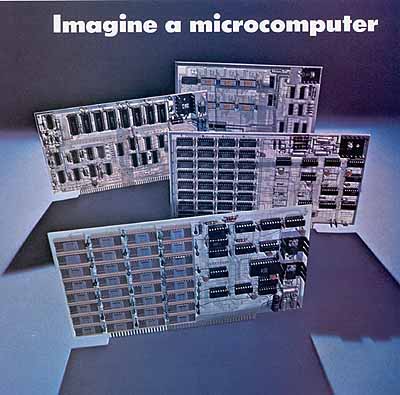
with a complete selection of
plug-in compatible boards
MITSí wide variety of plug-in compatible boards permits Altair 8800 series microcomputers to be configured for a limitless number of applications in business, industry, and home use. Included are the following:
Synchronous 4K Memory Board. Provides 4,096 bytes of RAM, and depends solely on the CPU for timing signals (no single shots). Contains memory protect circuitry, and address selection circuitry for any one of 16 starting locations in increments of 4K. Access time is
200-300 nanoseconds.
4K Static RAM memory board. Uses Intel 2102 A-4 memory chips with worst case access of 450 nanoseconds. Fully isolated from system bus, thus eliminating excessive capacitive loading.
16K Static RAM memory board. Two surprise features are minimal power requirements and fast access time. One 16K static draws less power than 4K static. Maximum access time is 215 nanoseconds. Four 16K static boards add up to the entire 64K of memory directly addressable by the Altair 8800 series microcomputers.
PROM memory board. Allows for 2K bytes of PROM. Uses either 1702 or 1702A PRO Ms. which are electrically programmable and erasable via ultraviolet light. Provides option of power down circuitry. PROM programmer also available.
Serial Interface board. User selectable for RS232, TTL, or TTY. Two ports allow interface to two I/O devices, each running at a different baud rate and each using different electrical interconnect. That is, the two ports operate entirely independent of each other. Baud rates from 110 to 9600.
Parallel Interface board. Up to four ports, each contains 16 data lines. Each line can be initialized as input or output to interface or terminal. Can handle two inputs (such as paper tape reader and keyboard) and two outputs (such as paper tape punch and printer) or any combination of custom applications. Fully TTL compatible. Four controllable interrupt lines.
Audio-cassette Interface. Allows for inexpensive mass storage via magnetic tape. Any type of tape recorder with wow and flutter less than 0.5% may be used.
Vector Interrupt. Provides the computer with eight priority levels of CPU interrupt.
Real Time Clock. Added onto the vector interrupt board, the RTC allows processor interrupts at one of four selectable rates. Offers two clock sources, the system clock which operates at 2 megahertz or the line frequency which operates at 60 hertz.
Analog to Digital Converter. Used to input analog signals to the Altair 8800 series microcomputers. Features include: unipolar or bipolar operation, 12-bit resolution, 50 microsecond conversion time, optional 8 multiplexed inputs, optional true instrumentation amplifier input, and vector interrupt capability.
Multiplexer. 24 analog input channels utilized in conjunction with the AID Converter. Features include: 24 single-ended or differential input signals, input buffer operational amplifiers, gain of up to 1,000; and free of CMOS switch latchup.